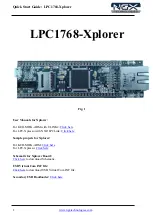
29
Figure 4-4 Monitoring switches and buttons
The ability to check the status of pushbutton and slider switches is not needed in typical design
activities. However, it provides a simple mechanism for verifying if the buttons and switches are
functioning correctly. Thus, it can be used for troubleshooting purposes.
4
4
.
.
4
4
M
M
e
e
m
m
o
o
r
r
y
y
C
C
o
o
n
n
t
t
r
r
o
o
l
l
l
l
e
e
r
r
The Control Panel can be used to write/read data to/from the SDRAM/EEPROM/EPCS on the
DE0-Nano board. As an example, we will describe how the SDRAM may be accessed; the same
approach is used to access the EEPROM and EPCS. Click on the Memory tab and select “SDRAM”
to reach the window in
Figure 4-5
.
Summary of Contents for De0-Nano
Page 1: ...1 ...
Page 4: ...4 9 3 Revision History 155 9 4 Copyright Statement 155 ...
Page 44: ...44 Figure 6 5 Browse to find the location Figure 6 6 There is no need to test the driver ...
Page 90: ...90 Figure 7 14 Add NIOS II Processor ...
Page 93: ...93 Figure 7 17 Rename the CPU 1 Figure 7 18 Rename the CPU 2 ...
Page 98: ...98 Figure 7 23 Add On Chip Memory ...
Page 100: ...100 Figure 7 25 Update Total memory size ...
Page 102: ...102 Figure 7 28 Update CPU settings ...
Page 104: ...104 Figure 7 30 Add PIO ...
Page 106: ...106 Figure 7 32 PIO 21 Rename pio_0 to pio_led as shown in Figure 7 33 Figure 7 33 Rename PIO ...
Page 113: ...113 Figure 7 43 Input verilog Text Figure 7 44 Open DE0_NANO_SOPC v ...
Page 146: ...146 Figure 8 16 Display Progress and Result Information for the SDRAM Demonstration ...
Page 150: ...150 Figure 9 3 Select Devices Page ...
Page 151: ...151 Figure 9 4 Convert Programming Files Page ...















































